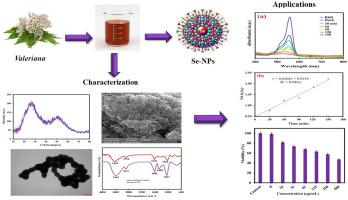缬草提取物生物合成纳米硒:环境修复和癌症治疗的双重途径
IF 2.8
Q1 MATERIALS SCIENCE, CERAMICS
引用次数: 0
摘要
本研究采用绿色合成的方法,以缬草(Valeriana officinalis)根提取物为生物制剂进行还原和稳定,制备硒纳米粒子(Se-NPs)。提取物中存在的植物化学物质可以在不使用有毒化学物质的情况下产生稳定的Se-NPs。利用紫外可见光谱、XRD、FTIR和TEM图像对纳米颗粒进行了广泛的表征,确认了它们的结构、形态和表面性质。Se-NPs具有良好的光催化性能,对罗丹明B (Rhodamine B, RhB)染料的光降解效率在150 min后达到98%。此外,生物实验显示纳米颗粒对癌症B16F0细胞具有选择性的细胞毒性。这种双重功能、光催化降解和选择性抗癌作用突出了Se-NPs在环境和生物医学领域的适用性。本文章由计算机程序翻译,如有差异,请以英文原文为准。

Biogenic synthesis of selenium nanoparticles from Valeriana officinalis extract: A dual approach for environmental remediation and cancer therapy
This study employed the green synthesis approach to produce Selenium nanoparticles (Se-NPs) using Valeriana officinalis (Valerian) root extract as a biological agent for reduction and stabilization. The phytochemicals present in the extract enabled the generation of stable Se-NPs without the use of toxic chemicals. The nanoparticles underwent extensive characterization using UV–Vis spectroscopy, XRD, FTIR, and TEM images, confirming their structural, morphological, and surface properties. The Se-NPs demonstrated photocatalytic performance, which was confirmed by the efficient photodegradation of Rhodamine B (RhB) dye (98 % after 150 min). Furthermore, biological assays revealed that the nanoparticles exhibited selective cytotoxicity toward cancer B16F0 cells. This dual functionality, photocatalytic degradation, and selective anticancer effect highlight the applicability of Se-NPs in environmental and biomedical fields.
求助全文
通过发布文献求助,成功后即可免费获取论文全文。
去求助
来源期刊

Open Ceramics
Materials Science-Materials Chemistry
CiteScore
4.20
自引率
0.00%
发文量
102
审稿时长
67 days
 求助内容:
求助内容: 应助结果提醒方式:
应助结果提醒方式:


